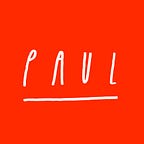Design Bold Or Don’t Design At All
In a world of endless distractions, only the boldest brands survive
While there are many designers and agencies in the industry that produce perfectly good branding design, truly innovative work is rare. It’s not for lack of skill or trying. In a world where our eyeballs are blasted with visual distraction in every waking moment, creating something different enough to actually stand out is no easy task. Can the ingredients of a stand-out design be quantified and if so, what are they?
Recognizing a great brand design
Great branding is bold. It is courageous. It breaks from current trends and stands out from the crowd. Above all, it challenges the individual viewing it. In fact, it is quite often met with hostility. Do these five stages of brand acceptance sound familiar?
- Denial
Huh, I don’t get it. This is absolutely awful. - Continued denial
I still don’t get it. - Curiosity
No, hold on a second, I’m seeing something here (squints at screen). - Epiphany
OMG, now I get it. This is fucking genius. - Depression
Why didn’t I think of that?
True originality is always controversial because it pushes beyond the realm of what is currently acceptable. And truthfully, it’s acceptable now, it probably already past it’s sell by date.
What makes a brand design innovative?
Simon Manchipp of London agency Someone coined the term “branding, not blanding” and it perfectly sums up what constitutes a great visual identity: A great brand is a brand that stands out from the crowd. This is the very core requirement of a great brand design. In the sea of noise that is the digital world, now more than ever, a brand needs to look radically different from it’s competitors.
Let’s take for example, the London 2012 logo. Love it or hate it, this branding project was probably one of most (if not the most) successful in the recent history of the Olympic Games identities. To the haters (and I know there’s some of you reading this), ask yourself this question: What Olympic logos of the past 20 years do you actually remember most? I’d hazard a guess that it is London 2012. For those that don’t remember some of the other logos (I certainly don’t), here’s a reminder:
Everything about this logo is different from the preceding Olympic logos. The bold, almost anarchist approach is in such contrast to the muted palette of the preceding, and indeed subsequent, Olympic logos. It’s not just the visual style of the London 2012 logo, you see a fundamentally different thought process went into creating this brand. Branding, not blanding.
Being bold doesn’t necessarily mean garish colors. The recent Met re-brand uses quite traditional serif typography, but the overall form is striking and was no less controversial than London 2012. And perhaps it is the partly the provocation itself that makes these brand designs so successful: they are unforgettable. People either love them or hate them. They spark heated debate. They stop people in their tracks. Above all, they contain a certain ‘magic’ that makes them difficult to ignore and even harder to forget.
Creating an unforgettable brand design
By its very nature, creating a truly innovative visual design language follows no set formula. But there are certainly some things to keep in mind in a design process.
- Context is key.
The respective industry that you are designing for will have a certain amount of visual ‘baggage’. Trying the most unlikely style for the category you are designing is certainly an easy way to stand out. For example, if you’re designing for a heavy metal band, use Comic Sans set in pink. - Fuck it up.
A great creative director I worked with in New York used to always say this: “Make the most beautiful, pretty, creative design you can … then fuck it up.” It is this twist that can make something ordinary transform into unexpected and ‘magic’. A crude way to illustrate this: take your logo, print it out, use as toilet paper and rescan it. I promise the result will be more interesting (although perhaps not the most on-strategy). - Iterate, iterate, iterate. Then iterate some more.
When it comes to creating innovative design, there is no shortcut. The ‘twist’ that makes it truly unique will only come after rounds and rounds of iteration. Last year we were working on a campaign for a financial institution. After a week of work, we has produced nearly fifty versions of the creative. While all were pretty good we still felt none were great. It was getting close to the client deadline and we were about to start prepping the “best of a bad lot” for the presentation. Then, out of nowhere, at 11pm one day before, we hit on the solution. The bottom line: Think it’s finished? Do one more round. I promise it will be worth it.
The ‘safe test’
So you’ve followed all of the above and think you have something innovative. Look at your work and ask yourself these questions:
- Does it make me uncomfortable?
- Do I feel at least a little silly / embarrassed when I present it?
If the answer to either of the above is no, then you haven’t pushed your design far enough. Take it back to the drawing board. It needs more work.
